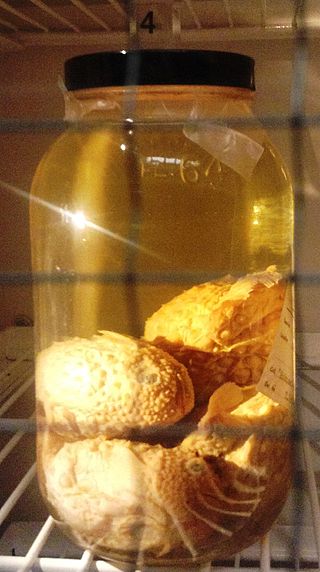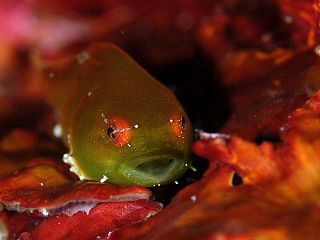
The Cyclopteridae are a family of marine fishes, commonly known as lumpsuckers or lumpfish, in the order Scorpaeniformes. They are found in the cold waters of the Arctic, North Atlantic, and North Pacific oceans. The greatest number of species are found in the North Pacific. The family name Cyclopteridae derives from the Greek words κύκλος (kyklos), meaning "circle", and πτέρυξ (pteryx), meaning "wing" or "fin", in reference to the circle-shaped pectoral fins of most of the fish in this family.
Cyclopsis is a monospecific genus of marine ray-finned fish belonging to the family Cyclopteridae, the lumpfishes or lumpsuckers. Its only species is Cyclopsis tentacularis which is found at depths between 12 and 140 m in the Sea of Okhotsk in the northwestern Pacific Ocean. This species has a maximum published standard length of 7.1 cm (2.8 in).
Cyclopteropsis is a genus of marine ray-finned fishes belonging to the family Cyclopteridae, the lumpfishes or lumpsuckers. These small lumpfishes are found in the North Pacific and Arctic Oceans.

Eumicrotremus is a genus of lumpfishes native to the northern oceans. The name for this genus comes from the Greek roots eu meaning "good", mikros meaning "small" or "little", and trema meaning "hole".

Lethotremus is a monospecific genus of marine ray-finned fish belonging to the family Cyclopteridae, the lumpfishes or lumpsuckers. This genus is found in the northern Pacific Ocean. Following a 2017 taxonomic review by Lee et al., the species Lethotremus awae was reclassified as a species of Eumicrotremus, leaving the genus monotypic with Lethotremus muticus as its only species. Also known as the docked snailfish, is a species of lumpfish native to the Northeast Pacific. It is known from the Bering Sea and the Aleutian Islands, where its range extends to Unimak Pass, and it occurs at a depth range of 58 to 330 m. It is a benthic species that reaches 11.5 cm in total length. It can be found on substrates of mud, rock, or gravel, and it is currently the only known species of Lethotremus, following a reclassification of the second described species in the genus as Eumicrotremus awae.
Eumicrotremus barbatus, the papillose lumpsucker, is a species of marine ray-finned fish belonging to the family Cyclopteridae, the lumpfishes or lumpsuckers, found in the north Pacific Ocean. This species is characterized by the following unique apomorphies: teeth in the outer row at symphysis of premaxillae fuse with premaxillae, teeth at symphysis of dentary fuse among themselves and with dentary, forming the regular cutting edge; there are numerous barbs on the head and body; the bony plaques located in centers of connective tissue tubercles leaving the edges free. This species was originally classified in the monospecific genus Georgimarinus, but it is now regarded as a species within Eumicrotremus.

The Pacific spiny lumpsucker is a species of bony fish in the family Cyclopteridae.
Cyclopteropsis brashnikowi is a species of lumpfish native to the Sea of Okhotsk and the Northwest Pacific off of the Kuril Islands, where it is found at a depth of 30 to 303 metres. Adult individuals of the species have been noted to resemble the related species C. popovi, suggesting that the two species names may be synonymous. It is of disputed classification, being considered a species of Eumicrotremus by some authors, although sources such as FishBase, WoRMS, and ITIS do not follow this classification.

The toad lumpsucker is a species of fish in the family Cyclopteridae that can be found in the Bering Sea and the Gulf of Alaska, where it occurs at depths of 69 to 170 metres. It is a demersal fish that reaches a maximum of 7.4 centimetres (2.9 in) in total length, making it a moderately sized member of Eumicrotremus.
Eumicrotremus andriashevi, also known as the pimpled lumpsucker, is a species of lumpfish native to the Arctic and North Pacific. In addition to the Arctic Ocean, it may be found in the Chukchi and Bering Seas, where it occurs at a depth range of 20 to 83 m. It is a small bottom-dwelling fish that reaches 4.8 cm in standard length.

Eumicrotremus asperrimus, also known as the Siberian lumpsucker, is a species of lumpfish native to the Northwest Pacific, where it can be found in the Bering Sea, the Sea of Japan, the Sea of Okhotsk, as well as off of Alaska and Hokkaido. It reaches 12 cm (4.7 in) in total length and occurs at a depth range of 20 to 900 m. It is a round and compact fish adorned with many distinct tubercles.

Eumicrotremus spinosus, commonly known as the Atlantic spiny lumpsucker, is a species of lumpfish native to the Arctic and North Atlantic.

Eumicrotremus awae is a species of lumpfish endemic to the Pacific coast of Honshu, Japan, where it may be found from Chiba to Mie. It is a very small fish, reaching a maximum of 2 cm (0.8 in) SL, and it occurs near shore at depths of less than 20 m (66 ft). This species is variable in color, being typically seen as either vibrant green or red. It is known to feed on extremely small crabs, and was previously known as Lethotremus awae until it was reclassified in 2017 following a taxonomic review and the descriptions of two similar "dwarf" species in Eumicrotremus.

Eumicrotremus pacificus, sometimes known as the spotted lumpsucker or the balloon lumpfish, is a species of lumpfish native to the Northwest Pacific. It can be found in the Sea of Okhotsk, the Sea of Japan, the East China Sea, and the Pacific Ocean off Hokkaido and the Kuril Islands. It may be confused with the closely related Eumicrotremus orbis, which overlaps with E. pacificus in range, although E. pacificus is larger, reaching 20 cm (7.9 inches) TL. This fish is generally yellow to orange in color with small dark spots and its tubercles are usually smaller and less pronounced than E. orbis, giving it a less spiny appearance.
Eumicrotremus schmidti is a species of lumpfish native to the Northwest Pacific. It is a demersal fish known only from the northern Sea of Okhotsk, where it is found at a depth range of 20 to 143 m. Specimens of E. schmidti were once attributed to the related species E. andriashevi, which does not inhabit the Sea of Okhotsk. This species was first formally described in 1955 by the Soviet ichthyologists Georgii Ustinovich Lindberg and Marina Iosifovna Legeza with its type locality given as Penzhinskaya Bay in the Sea of Okhotsk in Russia. The identity of the person honoured in the specific name was not given by Lindberg and Legeza but it is likely to be Petr Yulievich Schmidt, a Russian ichthyologist.
Eumicrotremus terraenovae, also known as the Newfoundland spiny lumpsucker, is a species of lumpfish native to the Northwest Atlantic. It is a demersal fish found off of Newfoundland and in the Gulf of Maine.
Eumicrotremus uenoi is a species of lumpfish native to the Northwest Pacific. It is found off the Korean Peninsula and Japan, where it occurs at a depth range of 90 to 100 m. It is a very small demersal fish, reaching 2 cm SL. The species was named after Dr. Tatsuji Ueno, formerly of the Hokkaido Fisheries Experimental Station, in honor of his work with the systematics of Cyclopteridae, the lumpfishes. It was described in 2017 following a taxonomic review of "dwarf" lumpfishes that also resulted in the description of Eumicrotremus jindoensis and the reclassification of the species Lethotremus awae as Eumicrotremus awae.
Eumicrotremus tokranovi is a species of lumpfish native to the Northwest Pacific, and one of two species some authorities place in the genus Microancathus. It is known from the Kuril Islands. It is distinguished from the closely related E. fedorovi by a taller body and flatter and less developed bone plaques. FishBase does not recognize the genus Microancathus,. This species was described by the Russian ichthyologist Olga Stepanovna Voskoboinikova in 2015 in the proposed new genus, Microancathus and the reclassification of M. fedorovi in that genus. Catalog of Fishes does not recognize the new genus and classifies this species in Eumicrotremus. The specific name honors the ichthyologist Alexei Mikhailovich Tokranovof the Kamchatka Branch of the Pacific Institute of Geography and the Far East Branch of the Russian Academy of Sciences.

Cyclopteroidea is a superfamily of ray-finned fishes within the order Scorpaeniformes. The superfamily comprises 2 families, the Cyclopteridae, the lumpsuckers, of the cool northern seas and the widespread Liparidae, the snailfishes. A common feature shared by these families is that they typically have the pelvic fins modified to form a disc shaped sucker.
Eumicrotremus fedorovi is a species of marine ray-finned fish belonging to the family Cyclopteridae, the lumpfishes or lumpsuckers. This species is found in the northwestern Pacific Ocean around the Kuril Islands. It is a demersal fish that occurs at a depth range of 115 to 370 m. This species was first formally described in 1991 by Sergey Anatolyevich Mandritsa with its type locality given as the Rikord Strait. The specific name honours the Russian zoologist Vladimir Vladimirovich Fedorov who studied the holotype and suggested that it represented a new species.








